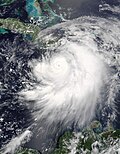Low pressure area
A low pressure area, or low for short, is a word used in meteorology (the study of weather) that means a place where the atmospheric pressure is lowest compared to the surrounding area. Coriolis effect causes winds to blow counter-clockwise in the northern hemisphere and clockwise in southern hemisphere. This makes storms like tropical cyclones, extratropical cyclones, subtropical cyclones, and subpolar cyclones. They are called "low-pressure cells" in some English-speaking countries.
Low Pressure Area Media
This depiction of the Hadley cell shows the process which sustains low-pressure areas. Diverging winds aloft allow for lower pressure and convergence at the Earth's surface, which leads to upward motion.
QuikSCAT image of typical extratropical cyclones over the ocean. Note the maximum winds on the poleward side of the occluded front.
A visible image of Hurricane Dennis intensifying in the Jamaica Channel.




